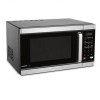Cuisinart CMW-110 User Manual - Page 6
Materials You Can Use In Microwave, Materials To Be Avoided In Microwave
 |
View all Cuisinart CMW-110 manuals
Add to My Manuals
Save this manual to your list of manuals |
Page 6 highlights
MATERIALS YOU CAN USE IN MICROWAVE Arcing is sparks or electric flashes that crackle or pop. Arcing can produce heat that is quite intense and can damage the interior of the microwave or containers being used in the microwave. It can also cause fire. Arcing occurs when certain metals are used in the microwave. To prevent arcing, use the charts below to determine which materials are microwave safe, or follow instructions from container/wrap manufacturer. Plastic cookware should be used carefully. Even microwave-safe plastic may not be as tolerant of overcooking conditions as are glass or ceramic materials and may soften or char if subjected to short periods of overcooking. In longer exposures to overcooking, the food and cookware could ignite. Follow these guidelines: Use microwave-safe plastics only and use them in strict compliance with the cookware manufacturer's recommendations. Do not microwave empty containers. Do not permit children to use plastic cookware without complete supervision. Browning Dish Use a browning dish in this microwave only if supplied with a microwave trivet that will lift the browning dish ³∕16-inch above the turntable. Incorrect usage may cause the turntable to break. Dinnerware Microwave-safe only. Follow manufacturer's instructions. Do not use cracked or chipped dishes. Glass Jars Glassware Always remove lid. Use only to warm food. Most glass jars are not heat resistant and may break. Heat-resistant oven glassware with no metallic trim only. Do not use if cracked or chipped. Oven Cooking Bags Follow manufacturer's instructions. Do not close with metal tie. Paper Plates and Cups Use for short-term cooking/warming only. Do not leave oven unattended while cooking. Should be labeled for use in microwave - with no color/dye. Paper Towels Cover food for reheating and absorbing fat. Use with supervision for short-term cooking only. Parchment Paper Use as a cover to prevent splattering or as a wrap for steaming. Plastic Microwave-safe only. Follow manufacturer's instructions. Plastic Wrap Microwave-safe only. Do not allow plastic wrap to touch food. Vent or pierce before cooking. Thermometers Microwave-safe only. Wax Paper Use as a cover to prevent splattering and retain moisture inside. MATERIALS TO BE AVOIDED IN MICROWAVE Aluminum tray May cause arcing. Transfer food to microwave-safe dish. Food carton with metal handle May cause arcing. Transfer to microwave-safe dish. Metal or metal-trimmed utensils Metal twist-ties Paper bags Plastic foam Wood Metal shields the food from microwave energy. Metal trim may cause arcing. May cause arcing and cause a fire in the oven. May cause a fire in the oven. Plastic foam may melt or contaminate the liquid inside when exposed to high temperature. Wood will dry out when used in the microwave oven and may split or crack. 6 cmw110_18ce050188_eng_ib.indd 6 2/23/18 3:58 PM















